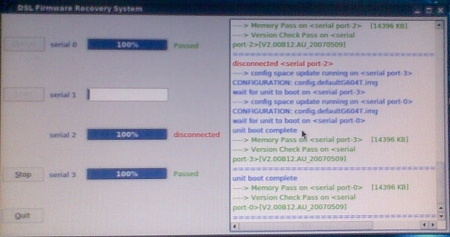D-Link Australia Uses Python to Control Firmware Updates
| Category: | Business |
|---|---|
| Keywords: | Firmware, Service, USB, Serial, Hardware Control, Network |
| Title: | D-Link Australia Uses Python to Control Firmware Updates |
| Author: | How Wong |
| Contact: | grandsonata at aol dot com |
| Date: | 2007/08/02 10:00:00 |
| Web site: | http://www.dlink.com.au/ |
| Summary: | D-Link Australia uses Python to control firmware updates performed for warranty services and realizes an eight-fold increase in its upgrade capacity. |
| Logo: | 
|
Introduction
D-Link Australia's RMA department provides warranty services to Australiasia. Warranty services consist of diagnosing, fixing, testing, refurbishing, and packaging security cameras, modems, voip hardware, switches and router products.
Problem Description
Prior to the development of the software described below, the standard method of upgrading firmware during warranty service was to load settings and firmware onto a modem through a web browser, after complete bootup of the firmware. With this technique only one modem could be upgraded at a time by each machine. To confirm successful upgrade of the firmware, the modem had to be rebooted and the version checked, again through a web browser.
Modems with firmware corruption, those that needed to be converted to a different localization region, and those that required an upgraded boot loader could not be handled this way. Instead, a separate executable was used to recover or convert at the boot-ROM level. On a typical day, there were hundreds of these requiring service, with many different models.
The Solution
To solve some of these problems, I started using a terminal script to drive serial communication to the modems, in order to bypass manual use of the web browser in the process of upgrading the firmware at the boot-ROM level, and to reduce the required number of boots of the modem down to one. Although this method eliminated many of the problems, there still remained the manual step of selecting firmware appropriate to the modem's model and using different commands for different boot loaders. Furthermore, only a single upgrade could be performed at a time. It was not a particularly user-friendly solution.
To improve the situation, I decided to develop custom software to handle the upgrades. I started by considering Java for performance but once I looked at the complex Java serial communication code and the language itself I chose Python instead. I was not a programmer and I felt I was not going to be able work with and understand Java code. I believed Python would allow me to focus more on the problem rather than the language.
DSL Firmware Recovery System
The development environment used for this work was Eclipse on Linux, using the pySerial module, tftp, and PyQt3. The hardware contained quad port serial and network cards and an RS-232 to TTL Serial interface that supports carrier detect.
The components of the software system were the network module, serial I/O module, a thread manager, and the GUI. A port manager detected online and offline modems, and managed connecting and freeing ports. Each thread handled one modem, connecting the network and serial interfaces. Once a modem was on, the serial buffer was continuously monitored and any common error would be detected. The correct firmware and settings files needed for each model's upgrade were picked up by the software system. FTP commands were used to control flashing memory regions and serial commands were used to control the boot process. Running processes displayed their status through the easy-to-read graphical and log user interface. The user interface also provided simple controls to start, stop, and select models for the modems.

The DSL Firmware Recovery System's user interface, showing the system in the process of upgrading four modems simultaneously Zoom in
The threading model was the most difficult to develop part of the software. I used the threading support provided by Qt, and found it easier to use than Python's threading module. When the main Qt program quits, it also automatically quits any qthreads that are still running.
Results
The project was a success. I was the sole creator and developer and was amazed at the results achieved in just over 1,200 lines of code. It took 2-3 months to develop the system, including testing.
Once completed, the DSL Firmware Recovery System was 8x faster on a single machine, and it made it possible to add additional machines and serial cards more easily. One day 1,600 modem firmware conversions were done, in addition to the normal daily workload.
The software also helped to prevent errors, so that the quality of service increased, and fewer defective modems were shipped out.
Conclusion
Although I was without programming experience, Python allowed me to simultaneously learn a programming language and accomplish a complex job. Python is a uniquely powerful and usable "learn-as-you-go feature-rich language."
Author
How Wong previously failed University programming and now works as a Linux technologist. He is interested in using Linux and open-source software to solve real world problems. Mr. Wong developed skills in the course of a varied IT career and in his spare time working in Python and web programming, multimedia, and Linux OS.

